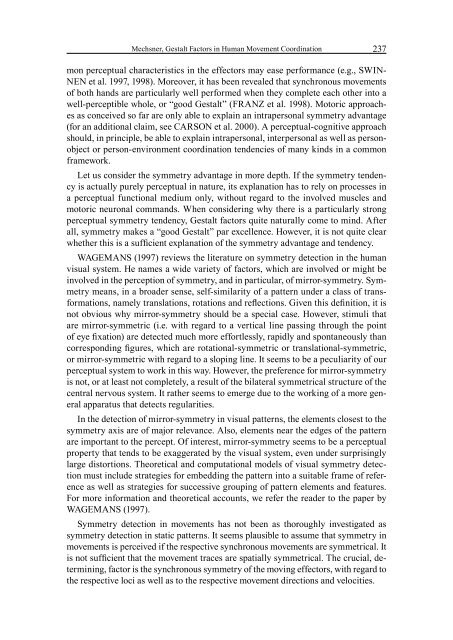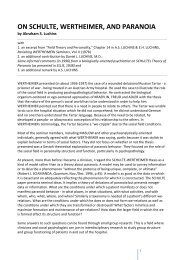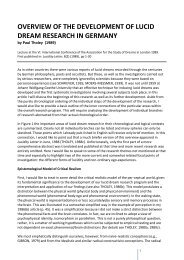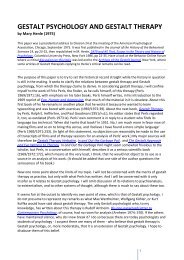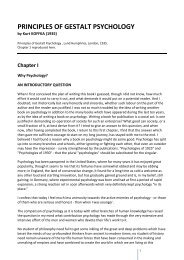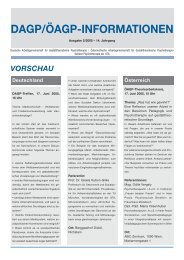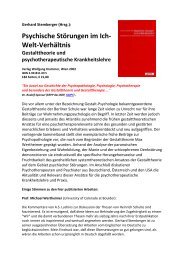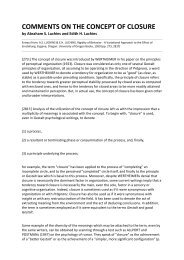Gestalt Factors in Human Movement Coordination - Society for ...
Gestalt Factors in Human Movement Coordination - Society for ...
Gestalt Factors in Human Movement Coordination - Society for ...
You also want an ePaper? Increase the reach of your titles
YUMPU automatically turns print PDFs into web optimized ePapers that Google loves.
Mechsner, <strong>Gestalt</strong> <strong>Factors</strong> <strong>in</strong> <strong>Human</strong> <strong>Movement</strong> Coord<strong>in</strong>ation 237mon perceptual characteristics <strong>in</strong> the effectors may ease per<strong>for</strong>mance (e.g., SWIN-NEN et al. 1997, 1998). Moreover, it has been revealed that synchronous movementsof both hands are particularly well per<strong>for</strong>med when they complete each other <strong>in</strong>to awell-perceptible whole, or “good <strong>Gestalt</strong>” (FRANZ et al. 1998). Motoric approachesas conceived so far are only able to expla<strong>in</strong> an <strong>in</strong>trapersonal symmetry advantage(<strong>for</strong> an additional claim, see CARSON et al. 2000). A perceptual-cognitive approachshould, <strong>in</strong> pr<strong>in</strong>ciple, be able to expla<strong>in</strong> <strong>in</strong>trapersonal, <strong>in</strong>terpersonal as well as personobjector person-environment coord<strong>in</strong>ation tendencies of many k<strong>in</strong>ds <strong>in</strong> a commonframework.Let us consider the symmetry advantage <strong>in</strong> more depth. If the symmetry tendencyis actually purely perceptual <strong>in</strong> nature, its explanation has to rely on processes <strong>in</strong>a perceptual functional medium only, without regard to the <strong>in</strong>volved muscles andmotoric neuronal commands. When consider<strong>in</strong>g why there is a particularly strongperceptual symmetry tendency, <strong>Gestalt</strong> factors quite naturally come to m<strong>in</strong>d. Afterall, symmetry makes a “good <strong>Gestalt</strong>” par excellence. However, it is not quite clearwhether this is a sufficient explanation of the symmetry advantage and tendency.WAGEMANS (1997) reviews the literature on symmetry detection <strong>in</strong> the humanvisual system. He names a wide variety of factors, which are <strong>in</strong>volved or might be<strong>in</strong>volved <strong>in</strong> the perception of symmetry, and <strong>in</strong> particular, of mirror-symmetry. Symmetrymeans, <strong>in</strong> a broader sense, self-similarity of a pattern under a class of trans<strong>for</strong>mations,namely translations, rotations and reflections. Given this def<strong>in</strong>ition, it isnot obvious why mirror-symmetry should be a special case. However, stimuli thatare mirror-symmetric (i.e. with regard to a vertical l<strong>in</strong>e pass<strong>in</strong>g through the po<strong>in</strong>tof eye fixation) are detected much more ef<strong>for</strong>tlessly, rapidly and spontaneously thancorrespond<strong>in</strong>g figures, which are rotational-symmetric or translational-symmetric,or mirror-symmetric with regard to a slop<strong>in</strong>g l<strong>in</strong>e. It seems to be a peculiarity of ourperceptual system to work <strong>in</strong> this way. However, the preference <strong>for</strong> mirror-symmetryis not, or at least not completely, a result of the bilateral symmetrical structure of thecentral nervous system. It rather seems to emerge due to the work<strong>in</strong>g of a more generalapparatus that detects regularities.In the detection of mirror-symmetry <strong>in</strong> visual patterns, the elements closest to thesymmetry axis are of major relevance. Also, elements near the edges of the patternare important to the percept. Of <strong>in</strong>terest, mirror-symmetry seems to be a perceptualproperty that tends to be exaggerated by the visual system, even under surpris<strong>in</strong>glylarge distortions. Theoretical and computational models of visual symmetry detectionmust <strong>in</strong>clude strategies <strong>for</strong> embedd<strong>in</strong>g the pattern <strong>in</strong>to a suitable frame of referenceas well as strategies <strong>for</strong> successive group<strong>in</strong>g of pattern elements and features.For more <strong>in</strong><strong>for</strong>mation and theoretical accounts, we refer the reader to the paper byWAGEMANS (1997).Symmetry detection <strong>in</strong> movements has not been as thoroughly <strong>in</strong>vestigated assymmetry detection <strong>in</strong> static patterns. It seems plausible to assume that symmetry <strong>in</strong>movements is perceived if the respective synchronous movements are symmetrical. Itis not sufficient that the movement traces are spatially symmetrical. The crucial, determ<strong>in</strong><strong>in</strong>g,factor is the synchronous symmetry of the mov<strong>in</strong>g effectors, with regard tothe respective loci as well as to the respective movement directions and velocities.


